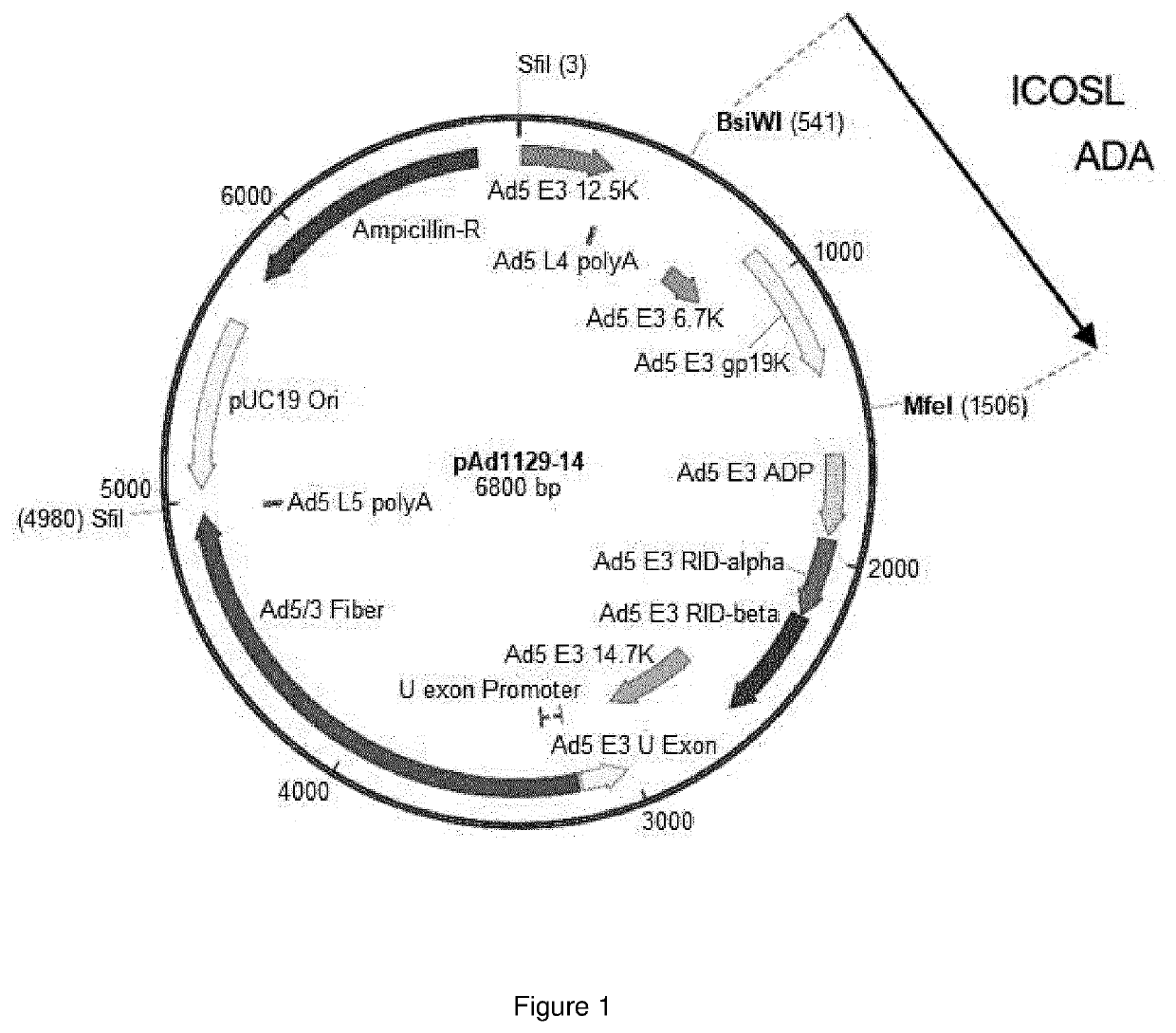Oncolytic adenoviral vector expressing a member of the b7 family of costimulatory ligands and ada
a technology of costimulatory ligands and oncolytic adenoviral vectors, applied in the field of cancer therapies, can solve problems such as impede anti-tumour immunity
- Summary
- Abstract
- Description
- Claims
- Application Information
AI Technical Summary
Benefits of technology
Problems solved by technology
Method used
Image
Examples
example 1
In Vitro—Cell Viability Assay (MTS)
[0225]Cell viability was evaluated by using the MTS Cell Proliferation Assay kit (Abcam) according to the manufacturer's instructions with the following modifications. MTS assay kit is a colorimetric method for the sensitive quantification of viable cells. It can be used to assess cell proliferation, cell viability and cytotoxicity. The MTS assay is based on the reduction of the MTS tetrazolium compound by viable mammalian cells to generate a coloured formazan dye that is soluble in cell culture media. This conversion is thought to be carried out by NAD(P)H-dependent dehydrogenase enzymes in metabolically active cells. The formazan dye is quantified by measuring the absorbance at 490 nm. Cells were seeded on 96 well plate at a concentration of 3000 and 5000 cells / well. Cells were incubated with and without 0.1, 1, 10, 100 and 1000 viral particles (VP) of tested virus. Treatment was initiated in a final volume of 200 μL. 72 hours later, MTS assay wa...
example 2
[0229]Complementary analysis on treatment efficacy focusing on evaluation of early and late apoptotic cells were carried out as well. Staining with Annexin V conjugates were carried out in order to identify cell membrane changes associated with early apoptosis. Cells were seeded on a 24 well plate at a density of 1.5×10{circumflex over ( )}4 cells per well for A2058 cell line. Treatment was initiated on the same day of plating and the amount of apoptotic and necrotic cells was measured 72 hours after the beginning of the treatment by flow cytometry, using the dead cell apoptosis kit, according to the manufacturer's instructions.
[0230]Double transgene virus coding for ICOSL and ADA (TGX-11) showed anti-cancer superiority (induction of apoptotic cell death) when administered at the concentration of 1000 VP / cell (respectively 175,43% of untreated cells) over single transgene viruses TGX-04 (coding for ICOSL, 120,76% of untreated cells), TGX-05 (coding for A...
example 3
In Vitro—Immunogenetic Cell Death (ICD)
[0231]It has been shown that cancer cell death can be immunogenic or non-immunogenic (Tesniere et al., 2008). Immunogenic cell death comprises changes in the structure of the cell surface and leads to the release of pro-immunogenic factors (Kroemer et al., 2013). Subsequently it attracts antigen presenting cells (APCs) to take up tumor antigens, process them, and finally elicit anti-tumor immune response (specific anti-tumor T cells) (Tesniere et al., 2008). The success of the cancer treatment relies on the induction of immunogenic tumor cell death and induction of anti-tumor immune responses (Kepp et al., 2011). Cell death can be evaluated by the presence of immunogenic cell death biomarkers such as calreticulin (CRT) on the outer plasma membrane, followed by extracellular release of high-mobility group box 1 protein (HM-GB1) and adenosine triphosphate (ATP) (Kepp et al., 2011, Obeid et al., 2007, Kroemer et al., 2013).
[0232]Cells were seeded ...
PUM
| Property | Measurement | Unit |
|---|---|---|
| pH | aaaaa | aaaaa |
| volume | aaaaa | aaaaa |
| concentration | aaaaa | aaaaa |
Abstract
Description
Claims
Application Information
 Login to View More
Login to View More - R&D
- Intellectual Property
- Life Sciences
- Materials
- Tech Scout
- Unparalleled Data Quality
- Higher Quality Content
- 60% Fewer Hallucinations
Browse by: Latest US Patents, China's latest patents, Technical Efficacy Thesaurus, Application Domain, Technology Topic, Popular Technical Reports.
© 2025 PatSnap. All rights reserved.Legal|Privacy policy|Modern Slavery Act Transparency Statement|Sitemap|About US| Contact US: help@patsnap.com



